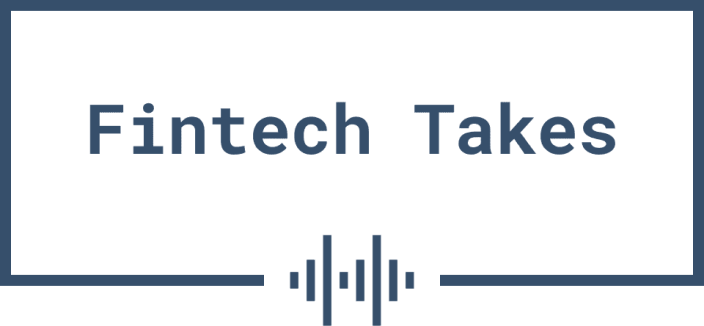
3 FINTECH NEWS STORIES
#1: Fintech is About to Break Credit Card Rewards
What happened?
A B2C fintech company raised a $10 million Series A:
Kudos uses artificial intelligence to figure out consumer spending habits so it can then provide more personalized financial advice, like maximizing rewards and utilizing credit effectively, Tikue Anazodo, co-founder and CEO of Kudos, told TechCrunch.
Consumers can use Kudos via an app and browser extension, similar to Honey.
Since 2022, Kudos grew from 1,000 beta testers to 200,000 registered users and increased annualized checkout gross merchandise volume to over $200 million, Anazodo said.
It also has some new features, including MariaGPT, an AI-powered card discovery tool indexing and recommending over 3,000 cards in its database; Dream Wallet, which provides personalized card recommendations based on a user’s spending habits; and Kudos Boost, which delivers personalized cash-back rewards on top of existing credit card rewards across over 15,000 partner brands and retailers.
So what?
Kudos is essentially a credit card rewards optimization browser plug-in for e-commerce shopping. In addition to picking the right card to use for every transaction, Kudos offers access to a network of integrated merchants offering additional rewards and a service that will recommend new credit cards for users who are looking to earn even more rewards (similar to Credit Karma or The Points Guy).
Those last two features are where the company makes money today, but it’s easy to see where the company can go from here.
Now that Visa has introduced Flexible Credential, which turns the 16-digit card number into a dynamic pointer that can switch between different cards based on rules set by the cardholder, I would guess that Kudos will launch its own reward optimization card (or sell white label-able software to help issuers enable this functionality for their own cards).
It’s perfect timing for an idea (dynamic rewards optimization) whose time has apparently come.
The larger implications of this trend will be fascinating. If you don’t need to be a spreadsheet-wielding fanatic (sorry Kiah!) in order to reap the maximum benefits provided by rewards credit cards, how will the issuers of those cards be able to continue offering them at their current levels?
Remember, when fintech companies automated the redemption of credit card issuers’ price protection benefits, the issuers quickly capped or eliminated that benefit.
Credit card rewards are a benefit that depends on a certain amount of breakage and sub-optimal use. If you change that, issuers will respond.
#2: Offer an Embedded Bank Account!
What happened?
PayHOA, a previously bootstrapped startup that has built a software platform for self-managed homeowner associations (HOAs), raised an impressive amount of money:
It just raised a $27.5 million Series A round in an environment where nearly $30 million Series A rounds are no longer common.
PayHOA says it is profitable (with positive EBITDA), which helps explain how it managed to land such a decent-sized Series A round in what remains a challenging fundraising environment, especially for non-AI startups. The 15-person startup notched year-over-over revenue growth of over 70%. It has more than 652,000 users, and makes money by charging a monthly subscription fee based on the number of units in the community. Prices start at $49 per month for HOAs with 25 units or less. Self-managed HOAs account for 30% to 40% of community associations, made up of 2.5 million volunteer board members.
So what?
Bootstrapping until you find product-market fit and only raising money once you’re profitable?
Love that.
Building a comprehensive vertical SaaS solution for a massive-yet-somehow-still-underserved niche?
Yes!
My big question about PayHOA is why the hell doesn’t it offer an embedded bank account for its HOA clients?
Today, the platform integrates into an HOA’s existing bank account(s) to process payments and reconcile transactions. Not only would all of those tasks be easier with an embedded bank account, and PayHOA would unlock a new source of revenue (debit card interchange), but banks would bludgeon each other to partner with PayHOA to get those deposits (HOA deposits are notoriously sticky and not price sensitive).
I admire PayHOA’s focus on building a strong SaaS business that can stand on its own, but it should absolutely get into embedded banking (or a bank should buy them).
#3: A Conversation Worth Having
What happened?
HSBC added a new feature to its app:
HSBC has added a feature to its mobile app in the UK to help customers identify, plan and manage their saving goals.
The ‘Savings Goal’ tool lets users choose from a list of short to medium term goals including travel, a new car or new business venture – and set the due date and amount target. They can then set up a regular transfer of funds into their savings account and track their progress.
The most popular savings goals according to the research are travel, emergency funds and home improvements, with 20% of the Gen Z population saving towards a house deposit.
So what?
Savings goals is not a new idea. It’s not even an old-news-for-fintech-but-innovative-for-banks new idea. This is very much table stakes (welcome to the game HSBC!)
However, I wanted to highlight it because I think banks and fintech companies are missing a trick when it comes to savings goals.
The value of savings goals isn’t about capturing deposits (though that is certainly nice). The value is the opportunity to engage the customer. They are saving for a reason. That reason is important! It is a signal that tells you where the customer is trying to go, financially speaking.
HSBC (and most financial services providers) capture this reason at only the most superficial level: selecting a goal from a drop-down list.
That’s not good enough! The customer says that they’re saving for a new business venture? What type of venture? How far along is it? Is it making money? Do they need help or advice in taking it to the next level? Are they working on it with anyone else?
Those are the types of questions that a well-trained banker would ask in a branch. Yet, in digitizing the savings experience, we’ve also dumbed it down.
This is likely because asking open-ended questions in a digital context has traditionally been difficult. And if you managed it, all you did was generate unstructured data that would be impossible to use.
Now that we have generative AI, this is no longer true. We can now build intelligent chatbots, powered by large language models, that can converse with customers. And the unstructured data in their responses can be parsed by those same models.
Finding out why your customers are saving money can only really be done through a conversation, and thanks to generative AI, that’s now a conversation worth having.
2 FINTECH CONTENT RECOMMENDATIONS
#1: Is Synapse’s Meltdown Fintech’s FTX Moment? (By Jason Mikula, Fintech Business Weekly) 📚
I’m assuming that y’all have been reading Mr. Mikula throughout this whole Synapse mess, but if not, please start with this piece. It’s a very useful, big-picture summary of where we’re at and what it might mean for the fintech ecosystem overall (spoiler alert – it’s not good).
#2: Follow-Up on Stripe: Always Forward (by Jareau Wadé, Batch Processing) 📚
Jareau’s coverage of Stripe’s recent product announcements has been great, and this follow-up on his original analysis is both good and intellectually honest. I appreciate the work he’s putting into Batch Processing right now.
1 QUESTION TO PONDER
I would like to have some off-the-record conversations with the CEOs of MoneyKit, Meld, Quilt, JustFi, Linker Finance, and Fuse. Can y’all please help me out?


